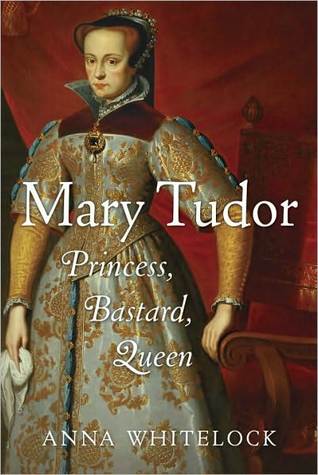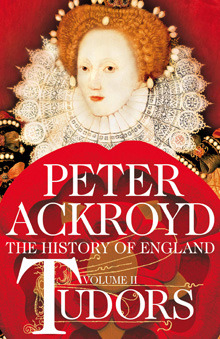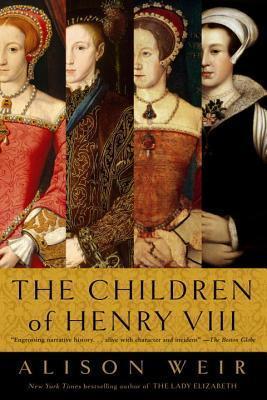Popular Mary I Books
15+ [Hand Picked] Popular Books On Mary I
Discover the list of some best books written on Mary I by popular award winning authors. These book on topic Mary I highly popular among the readers worldwide.

The First Queen of England: The Myth of "Bloody Mary" by Linda Porter
In this groundbreaking new biography of “Bloody Mary,” Linda Porter brings to life a queen best remembered for burning hundreds of Protestant heretics at the stake, but whose passion, will, and sophistication have for centuries been overlooked. Daughter of Henry VIII and Katherine of Aragon, wife of Philip of Spain, and sister of Edward VI, Mary Tudor was a cultured Renaiss In this groundbreaking new biography of “Bloody Mary,” Linda Porter brings to life a queen best remembered for burning hundreds of Protestant heretics at the stake, but whose passion, will, and sophistication have for centuries been overlooked. Daughter of Henry VIII and Katherine of Aragon, wife of Philip of Spain, and sister of Edward VI, Mary Tudor was a cultured Renaissance princess. A Latin scholar and outstanding musician, her love of fashion was matched only by her zeal for gambling. It is the tragedy of Queen Mary that today, 450 years after her death, she remains the most hated, least understood monarch in English history. Linda Porter’s pioneering new biography—based on contemporary documents and drawing from recent scholarship—cuts through the myths to reveal the truth about the first queen to rule England in her own right. Mary learned politics in a hard school, and was cruelly treated by her father and bullied by the strongmen of her brother, Edward VI. An audacious coup brought her to the throne, and she needed all her strong will and courage to keep it. Mary made a grand marriage to Philip of Spain, but her attempts to revitalize England at home and abroad were cut short by her premature death at the age of forty-two. The first popular biography of Mary in thirty years, The First Queen of England offers a fascinating, controversial look at this much-maligned queen.
I WANT TO READ THIS
Mary, Bloody Mary by Carolyn Meyer
The story of Mary Tudor's childhood is a classic fairy tale: A princess who is to inherit the throne of England is separated from her mother; abused by an evil stepmother who has enchanted her father; stripped of her title; and forced to care for her baby stepsister, who inherits Mary's rights to the throne. Believe it or not, it's all true. Told in the voice of the young The story of Mary Tudor's childhood is a classic fairy tale: A princess who is to inherit the throne of England is separated from her mother; abused by an evil stepmother who has enchanted her father; stripped of her title; and forced to care for her baby stepsister, who inherits Mary's rights to the throne. Believe it or not, it's all true. Told in the voice of the young Mary, this novel explores the history and intrigue of the dramatic rule of Henry VIII, his outrageous affair with and marriage to the bewitching Anne Boleyn, and the consequences of that relationship for his firstborn daughter. Carolyn Meyer has written a compassionate historical novel about love and loss, jealousy and fear - and a girl's struggle with forces far beyond her control.
I WANT TO READ THIS
Mary Tudor: Princess, Bastard, Queen by Anna Whitelock
This is a page-turning, revisionist history of the villainised and misunderstood Mary Tudor, the first queen of England.
I WANT TO READ THIS
In the Shadow of the Crown by Jean Plaidy
As Henry VIII's only child, the future seemed golden for Princess Mary. She was the daughter of Henry's first queen, Katharine of Aragon, and was heir presumptive to the throne of England. Red-haired like her father, she was also intelligent and deeply religious like her staunchly Catholic mother. But her father's ill-fated love for Anne Boleyn would shatter Mary's life fo As Henry VIII's only child, the future seemed golden for Princess Mary. She was the daughter of Henry's first queen, Katharine of Aragon, and was heir presumptive to the throne of England. Red-haired like her father, she was also intelligent and deeply religious like her staunchly Catholic mother. But her father's ill-fated love for Anne Boleyn would shatter Mary's life forever. The father who had once adored her was now intent on having a male heir at all costs. He divorced her mother and, at the age of twelve, Mary was banished from her father's presence, stripped of her royal title, and replaced by his other children--first Elizabeth, then Edward. Worst of all, she never saw her beloved mother again; Katharine was exiled too, and died soon after. Lonely and miserable, Mary turned for comfort to the religion that had sustained her mother. In a stroke of fate, however, Henry's much-longed-for son died in his teens, leaving Mary the legitimate heir to the throne. It was, she felt, a sign from God--proof that England should return to the Catholic Church. Swayed by fanatical advisors and her own religious fervor, Mary made horrific examples of those who failed to embrace the Church, earning her the immortal nickname "Bloody Mary." She was married only once, to her Spanish cousin Philip II--a loveless and childless marriage that brought her to the edge of madness. With In the Shadow of the Crown, Jean Plaidy brings to life the dark story of a queen whose road to the throne was paved with sorrow.
I WANT TO READ THIS
Tudors: The History of England from Henry VIII to Elizabeth I by Peter Ackroyd
Rich in detail and atmosphere and told in vivid prose, Tudors recounts the transformation of England from a settled Catholic country to a Protestant superpower. It is the story of Henry VIII's cataclysmic break with Rome, and his relentless pursuit of both the perfect wife and the perfect heir; of how the brief reign of the teenage king, Edward VI, gave way to the violent Rich in detail and atmosphere and told in vivid prose, Tudors recounts the transformation of England from a settled Catholic country to a Protestant superpower. It is the story of Henry VIII's cataclysmic break with Rome, and his relentless pursuit of both the perfect wife and the perfect heir; of how the brief reign of the teenage king, Edward VI, gave way to the violent reimposition of Catholicism and the stench of bonfires under 'Bloody Mary'. It tells, too, of the long reign of Elizabeth I, which, though marked by civil strife, plots against the queen and even an invasion force, finally brought stability. Above all, however, it is the story of the English Reformation and the making of the Anglican Church. At the beginning of the sixteenth century, England was still largely feudal and looked to Rome for direction; at its end, it was a country where good governance was the duty of the state, not the church, and where men and women began to look to themselves for answers rather than to those who ruled them.
I WANT TO READ THIS
Her Highness, the Traitor by Susan Higginbotham
As Henry VIII draws his last breath, two very different women, Jane Dudley, Viscountess Lisle, and Frances Grey, Marchioness of Dorset, face the prospect of a boy king, Edward VI. For Jane Dudley, basking in the affection of her large family, the coming of a new king means another step upward for her ambitious, able husband, John. For Frances Grey, increasingly alienated fr As Henry VIII draws his last breath, two very different women, Jane Dudley, Viscountess Lisle, and Frances Grey, Marchioness of Dorset, face the prospect of a boy king, Edward VI. For Jane Dudley, basking in the affection of her large family, the coming of a new king means another step upward for her ambitious, able husband, John. For Frances Grey, increasingly alienated from her husband and her brilliant but arrogant daughter Lady Jane, it means that she—and the Lady Jane—are one step closer to the throne of England. Then the young king falls deathly ill. Determined to keep England under Protestant rule, he concocts an audacious scheme that subverts his own father’s will. Suddenly, Jane Dudley and Frances Grey are reluctantly bound together in a common cause—one that will test their loyalties, their strength, and their faith, and that will change their lives beyond measure.
I WANT TO READ THIS
The King's Daughter by Barbara Kyle
Upon the death of her father, Henry VIII, Queen Mary assumes the throne after a long exile. Her first order of business is to wed the devout Prince Philip of Spain, creating a powerful alliance that will transform Mary's fanatical dream of ridding England of Protestantism into terrifying reality. And so begins the reign of Bloody Mary... Even as she plans for her own nuptia Upon the death of her father, Henry VIII, Queen Mary assumes the throne after a long exile. Her first order of business is to wed the devout Prince Philip of Spain, creating a powerful alliance that will transform Mary's fanatical dream of ridding England of Protestantism into terrifying reality. And so begins the reign of Bloody Mary... Even as she plans for her own nuptials, Isabel Thornleigh is helping to lay the groundwork to overthrow Mary and bring Elizabeth to power. But none of the secrets Isabel has discovered compares to the truths hidden in her own family. With her beloved father imprisoned by Queen Mary, only Carlos Valverde— a Spanish soldier of fortune—can help Isabel. Now with England's future at stake, Isabel risks all to change the course of history...
I WANT TO READ THIS
The Lady Elizabeth by Alison Weir
Following the tremendous success of her first novel, Innocent Traitor, which recounted the riveting tale of the doomed Lady Jane Grey, acclaimed historian and New York Times bestselling author Alison Weir turns her masterly storytelling skills to the early life of young Elizabeth Tudor, who would grow up to become England's most intriguing and powerful queen. Even at age t Following the tremendous success of her first novel, Innocent Traitor, which recounted the riveting tale of the doomed Lady Jane Grey, acclaimed historian and New York Times bestselling author Alison Weir turns her masterly storytelling skills to the early life of young Elizabeth Tudor, who would grow up to become England's most intriguing and powerful queen. Even at age two, Elizabeth is keenly aware that people in the court of her father, King Henry VIII, have stopped referring to her as "Lady Princess" and now call her "the Lady Elizabeth." Before she is three, she learns of the tragic fate that has befallen her mother, the enigmatic and seductive Anne Boleyn, and that she herself has been declared illegitimate, an injustice that will haunt her.
I WANT TO READ THIS
The Children of Henry VIII by Alison Weir
At his death in 1547, King Henry VIII left four heirs to the English throne: his only son, the nine-year-old Prince Edward; the Lady Mary, the adult daughter of his first wife, Catherine of Aragon; the Lady Elizabeth, the daughter of his second wife, Anne Boleyn, and his young great-niece, the Lady Jane Grey. These are the players in a royal drama that ultimate led to Eliz At his death in 1547, King Henry VIII left four heirs to the English throne: his only son, the nine-year-old Prince Edward; the Lady Mary, the adult daughter of his first wife, Catherine of Aragon; the Lady Elizabeth, the daughter of his second wife, Anne Boleyn, and his young great-niece, the Lady Jane Grey. These are the players in a royal drama that ultimate led to Elizabeth's ascension to the throne--one of the most spectacularly successful reigns in English history.
I WANT TO READ THIS
Tudor Queens of England by David Loades
An intimate and revealing look at the daily lives and responsibilities of the Tudor Queens of England From Elizabeth of York, wife of Henry VII, the first Tudor monarch, to Elizabeth I, her grand-daughter and the last, "The Tudor Queens of England" delves into the secret lives of some of the most colorful and dramatic women in British history. The majority of the fourteen An intimate and revealing look at the daily lives and responsibilities of the Tudor Queens of England From Elizabeth of York, wife of Henry VII, the first Tudor monarch, to Elizabeth I, her grand-daughter and the last, "The Tudor Queens of England" delves into the secret lives of some of the most colorful and dramatic women in British history. The majority of the fourteen queens considered here, from Catherine de Valois and Elizabeth Woodville to Elizabeth of York, Jane Seymour and Catherine Parr, were consorts, the wives of kings. Although less frequently examined than ruling queens, queen consorts played a crucial and central role within the Royal Court. Their first duty was to bear children and their chastity within marriage had to be above reproach. Any suspicion of sexual misconduct would cast doubt on the legitimacy of their offspring. Three of these women Margaret of Anjou, Anne Boleyn and Catherine Howard were accused of such conduct, and two were tried and executed. A queen also had to contribute to her husband's royal image. This could be through works of piety or through humble intercession. It could also be through her fecundity because the fathering of many children was a sign of virility and of divine blessing. A queen might also make a tangible contribution to her husband's power with her marriage as the symbol of an international diplomatic agreement. A ruling queen was very different, especially if she was married, insofar as she had to fill the roles of both king and queen. No woman could be both martial and virile, and at the same time submissive and supportive. Mary I solved this problem in a constitutional sense but never at the personal level. Elizabeth I sacrificed motherhood by not marrying. She chose to be mysterious and unattainable "la belle dame sans merci." In later life she used her virginity to symbolize the integrity of her realm and her subjects remained fascinated by her unorthodoxy. How did they behave (in and out of the bedchamber)? How powerful were they as patrons of learning and the arts? What religious views did they espouse and why? How successful and influential were they? From convenient accessory to sovereign lady the role of queen was critical, colorful, and often dramatic. "The Tudor Queens of England" is the first book of its kind to intimately examine these questions and more.
I WANT TO READ THIS
Mary Tudor: The Spanish Tudor by H.F.M. Prescott
Notorious for her persecution of Protestants, Queen Mary I has been vilified by generations of historians as Bloody Mary. But this award-winning biography offers a more humane and measured perspective on the life of this tormented woman. With sympathy, Prescott examines just how Mary, who was swept to the throne on a wave of popular acclaim, fell so far in her countrymen's Notorious for her persecution of Protestants, Queen Mary I has been vilified by generations of historians as Bloody Mary. But this award-winning biography offers a more humane and measured perspective on the life of this tormented woman. With sympathy, Prescott examines just how Mary, who was swept to the throne on a wave of popular acclaim, fell so far in her countrymen's esteem that just five years after her coronation, her death was greeted with universal relief.
I WANT TO READ THIS
Thomas Cranmer by Diarmaid MacCulloch
Thomas Cranmer, the architect of the Anglican Book of Common Prayer, was the archbishop of Canterbury who guided England through the early Reformation—and Henry VIII through the minefields of divorce. This is the first major biography of him for more than three decades, and the first for a century to exploit rich new manuscript sources in Britain and elsewhere. Diarmaid Mac Thomas Cranmer, the architect of the Anglican Book of Common Prayer, was the archbishop of Canterbury who guided England through the early Reformation—and Henry VIII through the minefields of divorce. This is the first major biography of him for more than three decades, and the first for a century to exploit rich new manuscript sources in Britain and elsewhere. Diarmaid MacCulloch, one of the foremost scholars of the English Reformation, traces Cranmer from his east-Midland roots through his twenty-year career as a conventionally conservative Cambridge don. He shows how Cranmer was recruited to the coterie around Henry VIII that was trying to annul the royal marriage to Catherine, and how new connections led him to embrace the evangelical faith of the European Reformation and, ultimately, to become archbishop of Canterbury. By then a major English statesman, living the life of a medieval prince-bishop, Cranmer guided the church through the king's vacillations and finalized two successive versions of the English prayer book. MacCulloch skillfully reconstructs the crises Cranmer negotiated, from his compromising association with three of Henry's divorces, the plot by religious conservatives to oust him, and his role in the attempt to establish Lady Jane Grey as queen to the vengeance of the Catholic Mary Tudor. In jail after Mary's accession, Cranmer nearly repudiated his achievements, but he found the courage to turn the day of his death into a dramatic demonstration of his Protestant faith. From this vivid account Cranmer emerges a more sharply focused figure than before, more conservative early in his career than admirers have allowed, more evangelical than Anglicanism would later find comfortable. A hesitant hero with a tangled life story, his imperishable legacy is his contribution in the prayer book to the shape and structure of English speech and through this to the molding of an international language and the theology it expressed.
I WANT TO READ THIS
Katherine the Queen: The Remarkable Life of Katherine Parr by Linda Porter
The general perception of Katherine Parr, the sixth and last wife of Henry VIII, is that she was a provincial nobody with intellectual pretensions who became queen of England because the king needed a matronly consort to nurse him as his health declined. In the various studies of the six wives of Henry VIII she receives much less attention than Katherine of Aragon or Anne The general perception of Katherine Parr, the sixth and last wife of Henry VIII, is that she was a provincial nobody with intellectual pretensions who became queen of England because the king needed a matronly consort to nurse him as his health declined. In the various studies of the six wives of Henry VIII she receives much less attention than Katherine of Aragon or Anne Boleyn. Her main achievement, in the famous rhyme about Henry's six wives, is that she 'survived'. Yet the real Katherine Parr was attractive, passionate (she had a mighty temper when aroused) ambitious and highly intelligent. She was thirty years old (younger than Anne Boleyn had been) when she married the king. Twice widowed, held hostage by the northern rebels during the great uprising of 1536-37 known as the Pilgrimage of Grace, her life had been dramatic even before she became queen. It would remain so after Henry's death, when she hastily and secretly married her old flame, the rakish Sir Thomas Seymour. Katherine died shortly after giving birth to her only child in September 1548, her brief happiness undermined by the very public flirtation of her husband and step-daughter, Princess Elizabeth. Despite the vivid interest of her life, this is the first full-scale, accessible biography of this fascinating woman who was, in reality, one of the most influential and active queen consorts in English history.
I WANT TO READ THIS
Wolf Hall by Hilary Mantel
England in the 1520s is a heartbeat from disaster. If the king dies without a male heir, the country could be destroyed by civil war. Henry VIII wants to annul his marriage of twenty years and marry Anne Boleyn. The pope and most of Europe opposes him. Into this impasse steps Thomas Cromwell: a wholly original man, a charmer and a bully, both idealist and opportunist, astu England in the 1520s is a heartbeat from disaster. If the king dies without a male heir, the country could be destroyed by civil war. Henry VIII wants to annul his marriage of twenty years and marry Anne Boleyn. The pope and most of Europe opposes him. Into this impasse steps Thomas Cromwell: a wholly original man, a charmer and a bully, both idealist and opportunist, astute in reading people, and implacable in his ambition. But Henry is volatile: one day tender, one day murderous. Cromwell helps him break the opposition, but what will be the price of his triumph?
I WANT TO READ THIS
Edward VI: The Lost King of England by Chris Skidmore
The birth of Edward on October 12, 1537, ended his father’s twenty-seven-year wait for an heir. Nine years later, Edward was on the throne, a boy-king in a court where manipulation, treachery, and plotting were rife. Henry VIII’s death in January 1547 marked the end of a political giant whose reign had dominated his kingdom with an iron grip for thirty-eight years. Few coul The birth of Edward on October 12, 1537, ended his father’s twenty-seven-year wait for an heir. Nine years later, Edward was on the throne, a boy-king in a court where manipulation, treachery, and plotting were rife. Henry VIII’s death in January 1547 marked the end of a political giant whose reign had dominated his kingdom with an iron grip for thirty-eight years. Few could remember an England without him--certainly little had remained untouched: the monasteries and friaries had been ripped down, the Pope’s authority discarded, and new authoritarian laws had been introduced that placed his subjects under constant fear of death. Edward came to the throne promising a new start; the harsh legislation of his father’s was repealed and the country’s social and economic problems approached with greater sensitivity. Yet the early hope and promise he offered soon turned sour. Despite the terms of Henry’s will, real power had gone to just one man--the Protector, Edward’s uncle, the Duke of Somerset, and there were violent struggles for power, headed by the duke’s own brother, Thomas Seymour. Chris Skidmore reveals how the countrywide rebellions of 1549 were orchestrated by the plotters at court and were all connected to the burning issue of religion: Henry VIII had left England in a religious limbo. Court intrigue, deceit, and treason very nearly plunged the country into civil war. The stability that the Tudors had sought to achieve came close to being torn apart in the six years of Edward’s reign. Even today, the two dominant figures of the Tudor period are held to be Henry VIII and Elizabeth I. Yet Edward’s reign is equally important. His reign was one of dramatic change and tumult, yet many of the changes that were instigated during this period--certainly in terms of religious reformation--not only exceeded Henry’s ambitions but have endured for over four centuries since Edward’s death in 1553.
I WANT TO READ THIS